Abstract
Among leafy stem vegetables, asparagus is attracting particular attention in Japanese agriculture. According to the data for 2022, the national asparagus harvest volume is up to 26kt and the cultivated area is up to 4.36kha. In terms of shipping volume, Hokkaido recorded the highest figure at 3.19kt. To date, asparagus production volumes and planted areas have remained relatively stable, and it is cultivated widely throughout the country. On the other hand, Hokkaido tends to be the top in terms of shipping volume. This may be because Hokkaido’s climate and land conditions are suitable for growing asparagus, and a production system is in place to meet the region’s unique demand. Japan’s asparagus industry continues to enjoy a stable supply, supported by high-quality production and an efficient distribution system. Further growth is expected in the future due to expanding demand and advances in production technology.
Asparagus harvest yield (main data).
Japan’s asparagus harvest volume will fluctuate between 2002 and 2022. The peak was recorded in 2010 at 31.4kt nationwide, and has since been on a slight downward trend, currently standing at 82.8% of its peak. This decline is due to a variety of agricultural factors, including climatic conditions, agricultural techniques and changes in demand. Also, keep in mind that asparagus tends to be grown in certain regions, and there is variation in production from one area to the next. Changes in demand and imports are also impacting yields. On the other hand, production may be increasing in some areas due to improvements in agricultural technology and increasing demand. Fluctuations in asparagus yields are also related to agricultural policies and market conditions, and future yields need to take these factors into account.
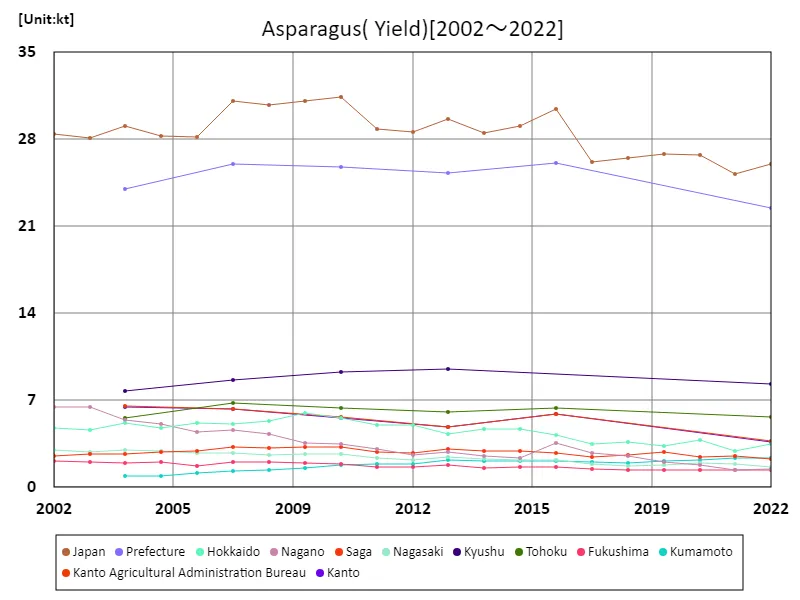

The maximum is 31.4kt[2010] of Japan, and the current value is about 82.8%
Asparagus harvest volume (by prefecture).
Based on prefecture-by-prefecture data for 2022, Hokkaido recorded the highest yield of leafy vegetables in Japanese agriculture at 3.5kt. Based on past trends, Hokkaido is a major producing area for leafy vegetables, and one factor that may be contributing to this is that the region’s climatic conditions and soil are suitable for cultivation. Hokkaido also has vast farmland, providing an ideal environment for producing leafy vegetables. On the other hand, leafy vegetables are also produced in other regions, but on a smaller scale than in Hokkaido, and yields tend to be proportionally lower. Demand for leafy vegetables is stable and production is driven by consumer demand. Although there are differences in the varieties cultivated and production techniques from region to region, overall there remains a stable supply. In the future, there is a possibility that production volumes in each region will fluctuate due to changes in demand and weather conditions, but leafy vegetables are positioned as one of the important crops in Japanese agriculture.
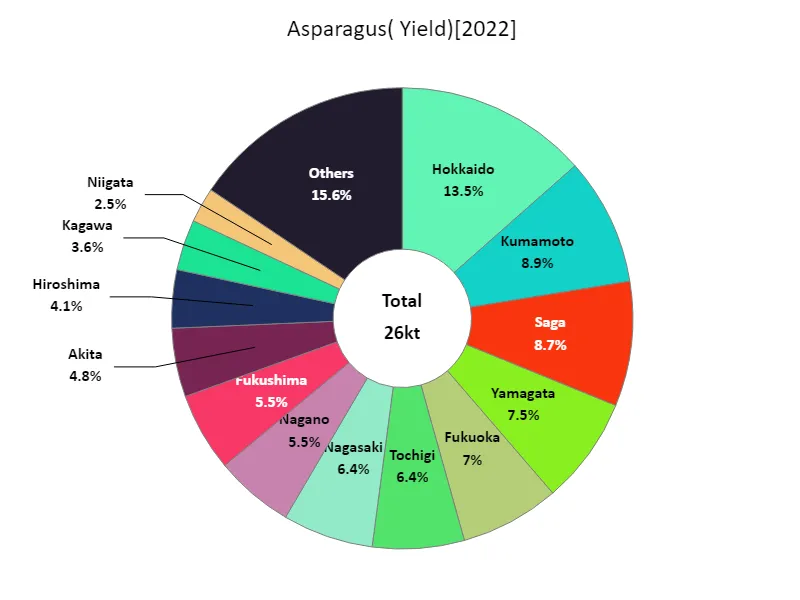

The maximum is 3.5kt of Hokkaido, the average is 552t, and the total is 26kt
Area cultivated with asparagus (main data).
The area of asparagus cultivated in Japanese agriculture will fluctuate between 2002 and 2022. The peak was recorded in 2008 at 6.54kha nationwide, but has been declining since then, currently standing at 66.7% of the peak. This decline is due to multiple agricultural factors, including shifts in demand across regions and the impact of agricultural policies. Another factor is that asparagus cultivation requires specific climate and land conditions, and in areas where these conditions are not met, the area that can be cultivated is limited. Additionally, changes in demand and imports are also impacting acreage. On the other hand, growing demand and improvements in agricultural technology may be increasing the area planted in some regions. Fluctuations in asparagus acreage are closely linked to agricultural economics and market conditions, and future acreage planning must take these factors into account.
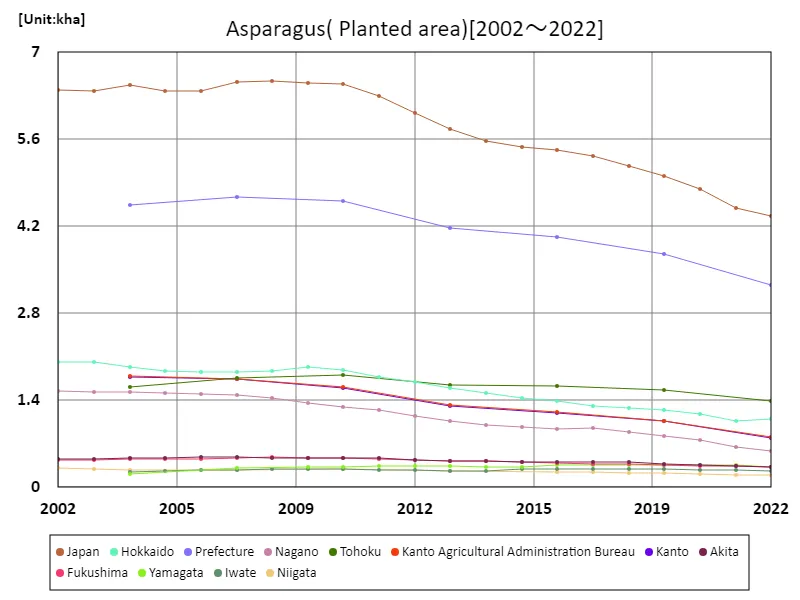

The maximum is 6.54kha[2008] of Japan, and the current value is about 66.7%
Asparagus cultivation area (by prefecture).
According to prefecture-by-prefecture data for 2022, Hokkaido has the largest area planted with leafy vegetables in Japan, at 1.1 kha. Looking at past trends, Hokkaido has been attracting attention as a major producer of leafy vegetables. One reason for this is that Hokkaido has vast farmland, a relatively cool climate, and rich soil that are well suited to growing leafy vegetables. Hokkaido is also proactively promoting advances in agricultural technology and improving production systems, and is producing high-quality leafy vegetables. On the other hand, leafy vegetables are also cultivated in other regions, but on a smaller scale than in Hokkaido, and the cultivated area tends to be proportionally smaller. Although there are differences in the varieties cultivated and production techniques from region to region, overall there remains a stable supply. Changes in demand and climatic conditions also affect the area planted, but it is notable that leafy vegetable production is centered in Hokkaido. Leafy vegetable production is expected to continue to grow due to expanding demand and technological innovation.
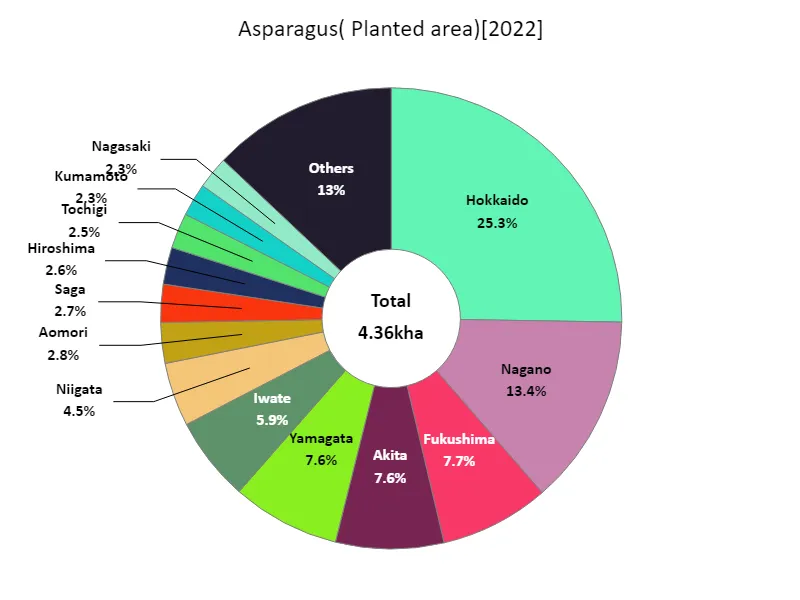

The maximum is 1.1kha of Hokkaido, the average is 92.7ha, and the total is 4.36kha
Asparagus shipment volume.
According to data for 2022, Japan’s total asparagus shipments were 23.1kt, of which Hokkaido accounted for 3.19kt. The average shipping volume is 492t. A notable feature of this data is that Hokkaido accounts for the majority of total shipping volume. Hokkaido has a climate and soil suitable for growing asparagus, and its quality is highly regarded. Therefore, it is natural that Hokkaido ships more asparagus than other regions. On the other hand, overall shipments of 23.1kt indicate that demand for asparagus remains relatively stable. Stable demand suggests that consumers recognize the value of asparagus, supporting demand. In addition, the average shipping volume of 492 tons indicates that asparagus production is being carried out on a certain scale and that supply continues to meet demand. Overall, Japan’s asparagus shipping volume is stable, with Hokkaido being the main production area.
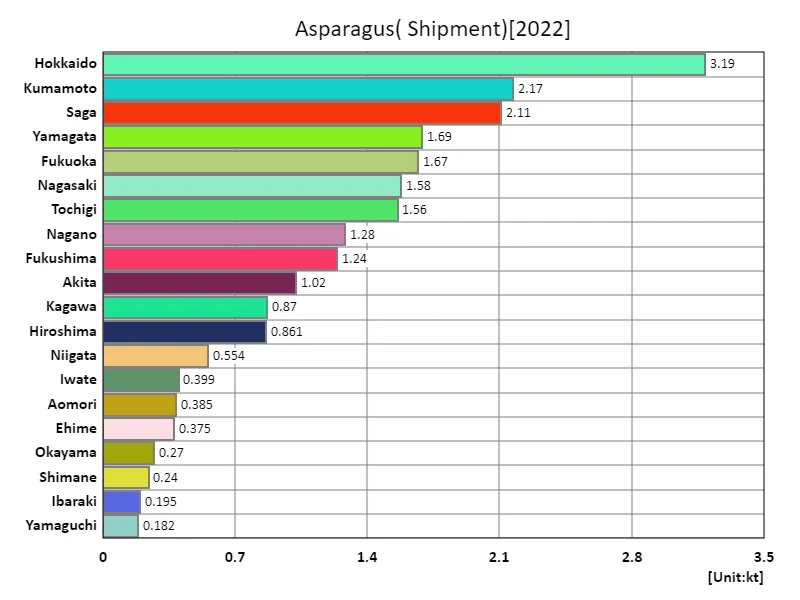

The maximum is 3.19kt of Hokkaido, the average is 492t, and the total is 23.1kt
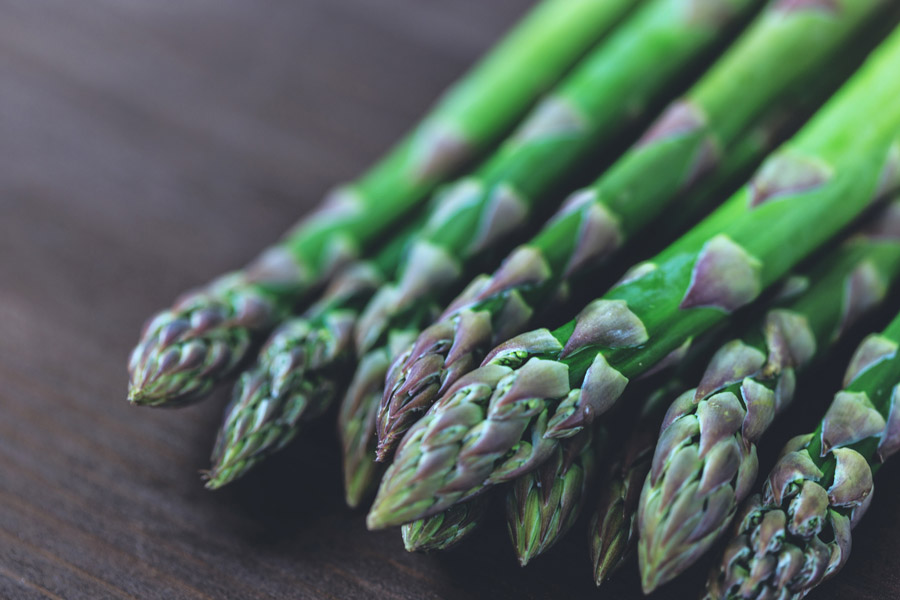


Comments